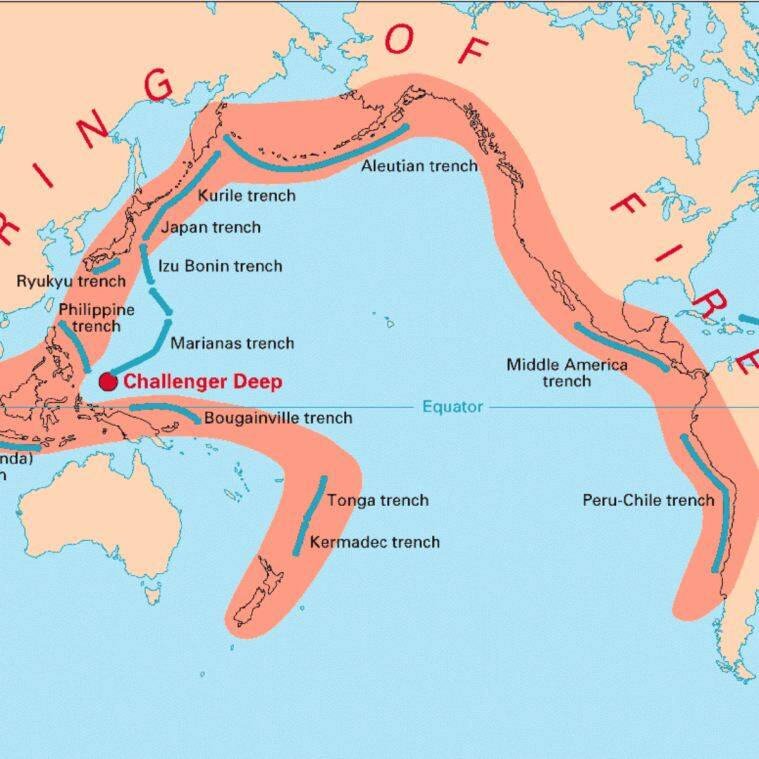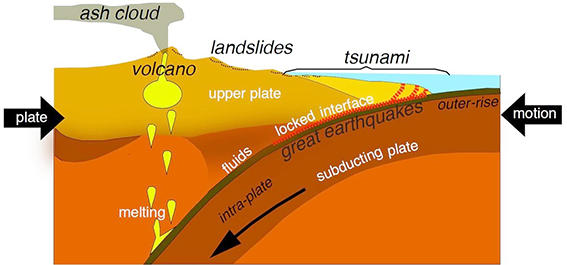Pacific Ring of Fire | 20 Jan 2022
For Prelims: Pacific Ring of Fire, Volcano, Earthquakes, Tectonic Plates, Subduction.
For Mains: Features and Causes of Frequent Earthquakes in the Pacific Ring of Fire.
Why in News
The Pacific ‘Ring of fire’ is situated just over 60 kilometers from the island nation of Tonga, where recently Hunga Tonga-Hunga Ha’apai volcano erupted sending ash and smoke thousands of feet into the air.
Key Points
- About:
- Also called Pacific rim or the Circum-Pacific Belt, is an area along the Pacific Ocean that is characterized by active volcanoes and frequent earthquakes.
- It is home to about 75% of the world’s volcanoes – more than 450 volcanoes. Also, about 90% of the world’s earthquakes occur here.
- Geographical Stretch:
- The Ring of Fire is stretched to approximately 40,000 kilometers tracing boundaries between several tectonic plates including the Pacific, Juan de Fuca, Cocos, Indian-Australian, Nazca, North American, and Philippine Plates.
- The chain runs up along the western coast of South and North America, crosses over the Aleutian Islands in Alaska, runs down the eastern coast of Asia past New Zealand and into the northern coast of Antarctica.
- Bolivia, Chile, Ecuador, Peru, Costa Rica, Guatemala, Mexico, United States, Canada, Russia, Japan, Philippines, Australia, Papua New Guinea, Indonesia, New Zealand, and Antarctica are some of the important places located in the ring of the fire.
- Causes of Volcanic Activity:
- Tectonic plates move towards each other creating subduction zones. One plate gets pushed down or is subducted by the other plate. This is a very slow process – a movement of just one or two inches per year.
- As this subduction happens, rocks melt, become magma and move to Earth’s surface and cause volcanic activity.
- In the case of Tonga, the Pacific Plate was pushed down below the Indo-Australian Plate and Tonga plate, causing the molten rock to rise above and form the chain of volcanoes.
- Recent Research:
- The Pacific Plate, which drives much of the tectonic activity in the Ring of Fire, is cooling off.
- Scientists have discovered that the youngest parts of the Pacific Plate (about 2 million years old) are cooling off and contracting at a faster rate than older parts of the plate (about 100 million years old).
- The younger parts of the plate are found in its northern and western parts, the most active parts of the Ring of Fire.
- Subduction happens when tectonic plates shift, and one plate is pushed under another. This movement of the ocean floor produces a "mineral transmutation", which leads to the melting and solidification of magma i.e., the formation of volcanoes.
- In other words, when a "downgoing" oceanic plate is pushed into a hotter mantle plate, it heats up, volatile elements mix, and this produces the magma. The magma then rises up through the overlying plate and spurts out at the surface.
- A subduction zone is the biggest crash scene on Earth. These boundaries mark the collision between two tectonic plates.
- When two tectonic plates meet at a subduction zone, one bends and slides underneath the other, curving down into the mantle, the hotter layer under the crust.


